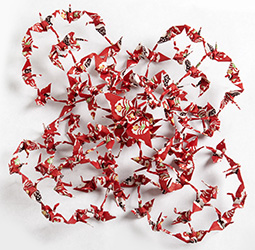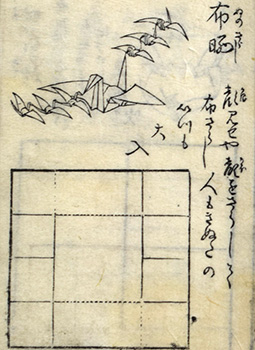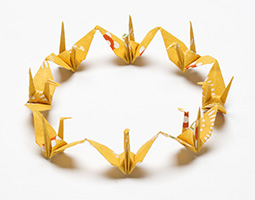INDEX
- English
- 日本語
- English
- 日本語

Example of a renzuru design named Nunozarashi presented by Otsuka Yurami to representatives from seven countries at the Junior Summit in Mie in 2016

Otsuka Yurami, history specialist at Kuwana City Museum 
Hyakkaku—a string of ninety-seven cranes folded from a single sheet of paper 
A page showing how to make Nunozarashi from the Hiden Senbazuru Orikata book in the Choen-ji temple collection 
Yatsuhashi—a circular design connecting eight cranes
December 2021
Renzuru: Linked Origami Cranes Made from a Single Sheet of Paper

Renzuru is a unique style of origami (folded paper) crane in which many interlocked cranes are folded from a single sheet of paper, using a technique that has been passed down for more than two centuries. Efforts are under way to revive this creative origami style and pass it on to future generations.

Folded paper cranes are probably the most familiar form of origami to the Japanese. As the Japanese proverb “cranes live for 1,000 years; turtles for 10,000” suggests, in Japan cranes are birds considered to possess longevity and impart good luck. There is also a custom of making many origami cranes and threading them together to form a senbazuru (literally, “string of a thousand cranes”) as a prayer for peace, alongside health and safety.
In Kuwana City, Mie Prefecture, a traditional technique for making remarkably complex and graceful origami cranes continues to be passed down. This is the technique of renzuru, wherein cuts are made to a single sheet of paper to create an interlocking string of multiple cranes. Long ago, the technique was also referred to as senbazuru.

In 1797, Hiden Senbazuru Orikata (“Secret to Folding One-thousand Cranes”) was released by a Kyoto-based publisher. The book presented diagrams for various simple renzuru folding methods, illustrations of the completed designs, and accompanied each with an elegant title and kyoka* poem. Later investigations have determined that this book is the oldest publication on renzuru in existence, and that the author was Roko-an Gido (1762–1834), a Buddhist priest at Choen-ji temple in Kuwana City, Mie Prefecture. In 1976, this discovery led to Kuwana City designating the forty-nine varieties of renzuru featured in the book as an Intangible Cultural Property of Kuwana City, dubbed Kuwana no Senbazuru (“The Thousand Cranes of Kuwana”).

“The ‘Thousand Cranes of Kuwana’ depicts renzuru that link anywhere from two to a maximum of ninety-seven cranes folded from a single sheet of paper,” explains Otsuka Yurami, a history specialist working at the Kuwana City Museum.
At the time Kuwana no Senbazuru was designated an Intangible Cultural Property, only a handful of people had actually folded the origami creations to which it referred. Hiden Senbazuru Orikata did not include detailed explanations of folding methods, and the folding diagrams were vague in places. It was Otsuka who unlocked each of its mysteries and thereby ensured that its designs could be reproduced by anyone.
“I think the renzuru that Gido developed represent creative thinking that deserves to be passed on to future generations,” says Otsuka.
Today, Otsuka and one other staff member have been accredited by Kuwana City as keepers of the Kuwana no Senbazuru techniques, and are working hard to pass on their knowledge. Through various activities such as paper folding lessons at elementary and junior high schools around the city and public workshops offered at the museum, many residents of Kuwana City are now familiar with Kuwana no Senbazuru.

At the “Junior Summit in Mie” held in Kuwana City in connection with the G7 Ise-Shima Summit in 2016, Otsuka folded and presented children participating from seven countries with Nunozarashi, one of the varieties of renzuru that appears in the Kuwana no Senbazuru. The children shouted with joy at the sight of seven origami cranes made from exquisite Japanese paper connected to one another, as if children from seven countries were holding hands.
“Long ago, people must have put their hearts into folding these time-consuming renzuru before presenting their creations to people close to them,” says Otsuka, who remains devoted to researching renzuru folding techniques for posterity.
* Kyoka is a humorous form of classical poetry similar to tanka, with five lines consisting of five, seven, five, seven and seven (5-7-5-7-7) syllables in each line. It was popular during the middle of the Edo period (1603-late 1860s).

